
Are you tired of coming home to an empty house? Imagine, instead, being greeted by a playful and affectionate companion eagerly awaiting your return.
The Pugalier dog breed may be just the furry friend you’ve been searching for. With their lovable appearance and charming personality, Pugaliers have captured the hearts of many dog lovers. But what sets them apart from other breeds?
In this article, we will explore the unique characteristics and traits of Pugaliers, shedding light on why they make such delightful companions. So, if you’re curious to learn more about this adorable breed, stay tuned for an in-depth look into the world of Pugaliers.
Key Takeaways
- Pugaliers are a small breed of dog originating from the United States, with an average weight of 10-20 pounds and a height of 10-12 inches.
- They are adaptable to apartment living and can thrive in small spaces, as long as their exercise and mental stimulation needs are met.
- Pugaliers are known for their affectionate nature and are suitable for novice owners. They tolerate being alone and can adapt to different weather conditions.
- When choosing a Pugalier, it is important to consider their potential for barking or howling, as well as their wanderlust potential. Additionally, regular veterinary care, balanced nutrition, and proper grooming are essential for their health and well-being.
General Information and Characteristics
Pugaliers, a mixed breed originating from the United States, are small dogs with a short and smooth coat. They typically weigh between ten to 20 pounds and stand about ten to 14 inches tall at the shoulder. Due to their King Charles Spaniel and Pug parentage, Pugaliers are generally small in size. It’s important to note that there are no specific size standards for this breed, as size can vary depending on the dominant genes of the parents.
In terms of health, Pugaliers can be prone to certain issues such as hip dysplasia, heart conditions, patellar luxation, and dry eye. Regular veterinary checkups, a balanced diet, exercise, and proper care are crucial to maintain their health and well-being.
See another Dog breed profile.
Puggle Dog Breed
Adaptability and Living in an Apartment
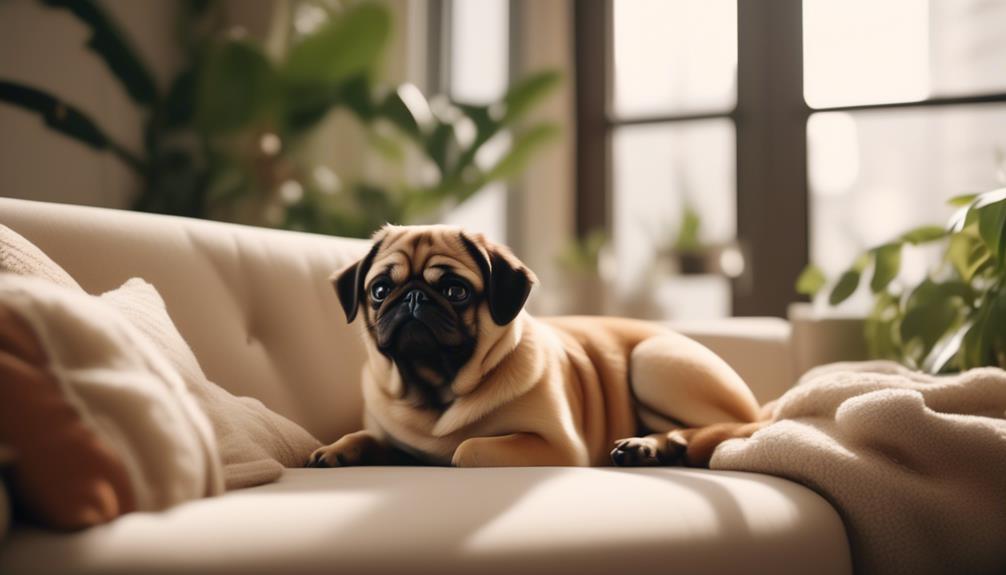
When considering the adaptability of a dog breed to apartment living, it’s important to prioritize qualities such as being quiet, low-energy, and exhibiting good manners. Here are three factors to consider when choosing a dog for an apartment:
- Size isn’t the only factor: While certain small breeds can thrive in apartments, size alone shouldn’t be the sole determinant. Consider energy levels and space requirements as well.
- Good manners when living in close proximity to others: It’s crucial to create a harmonious living environment. Prioritize qualities like being quiet, low-energy, and calm indoors to ensure a pleasant experience for both you and your neighbors.
- Consider neighbors’ comfort: Certain breeds may have a tendency to bark or howl more than others. Noise restrictions in housing or close proximity to neighbors may require a quieter dog. Take into account whether you find a dog’s barking or howling musical or maddening.
Friendliness and Temperament
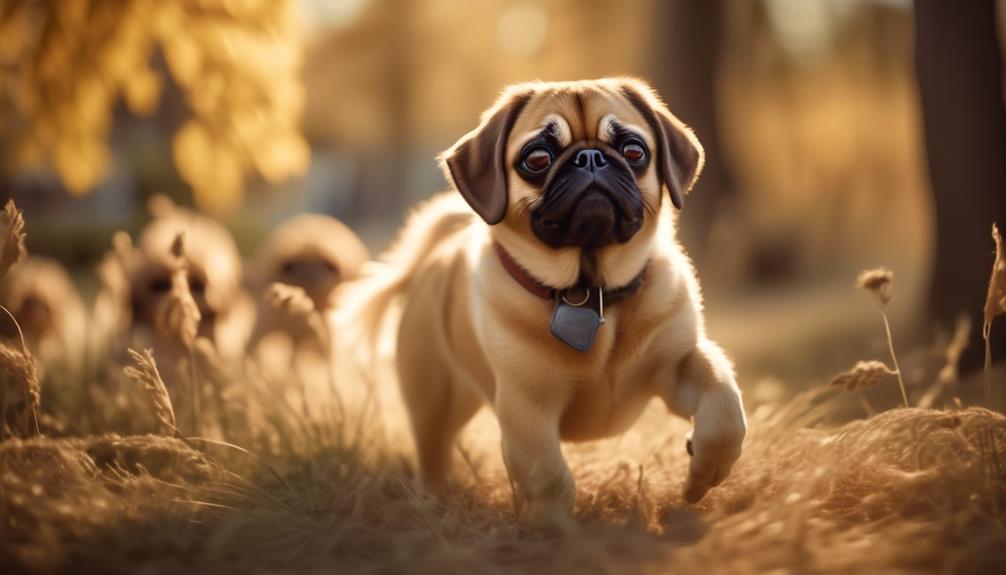
Consider the friendliness and temperament of a dog breed when choosing the perfect companion for your apartment lifestyle.
Pugaliers are known to be affectionate with their families, making them a great choice for novice owners. However, their sensitivity levels can vary, so it’s important to provide them with proper socialization and training.
Pugaliers are generally tolerant of being alone and can adapt well to apartment living. It’s crucial to prioritize good manners and low energy levels when living in close proximity to others.
Additionally, understanding the characteristic of aggression is important when selecting a suitable breed. Pugaliers have a low prey drive, which makes them less likely to display aggression towards humans.
Barking, Howling, and Wanderlust Potential
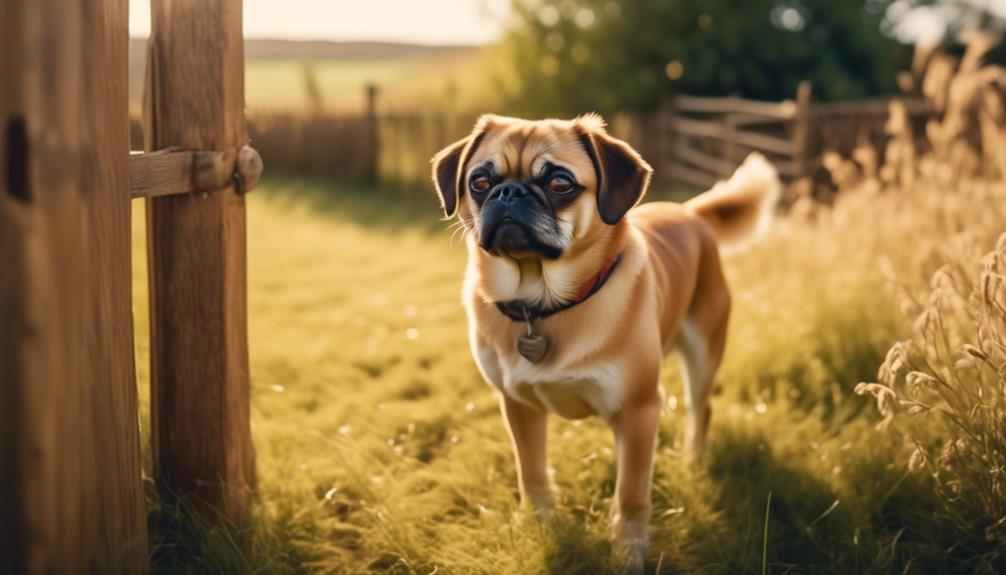
To assess a dog’s barking, howling, and wanderlust potential, it’s important to consider their breed and individual characteristics. When it comes to these traits, Pugaliers exhibit the following tendencies:
- Barking or Howling: Certain breeds have a tendency to vocalize more than others. Before getting a Pugalier, consider whether you find their barking or howling musical or maddening. Additionally, dogs with a watchdog instinct may be on constant alert in a city full of strangers, which could result in excessive barking.
- Wanderlust Potential: Some breeds are more free-spirited and prone to wandering. Nordic dogs like Siberian Huskies have a strong urge to range long distances, while hounds may follow their noses or chase after wildlife. On the other hand, dogs less prone to wander are more likely to stay close to their owners.
Understanding these aspects can help you choose a Pugalier that fits well with your lifestyle and preferences.
Exercise, Playfulness, Size, Health, Care, and Feeding
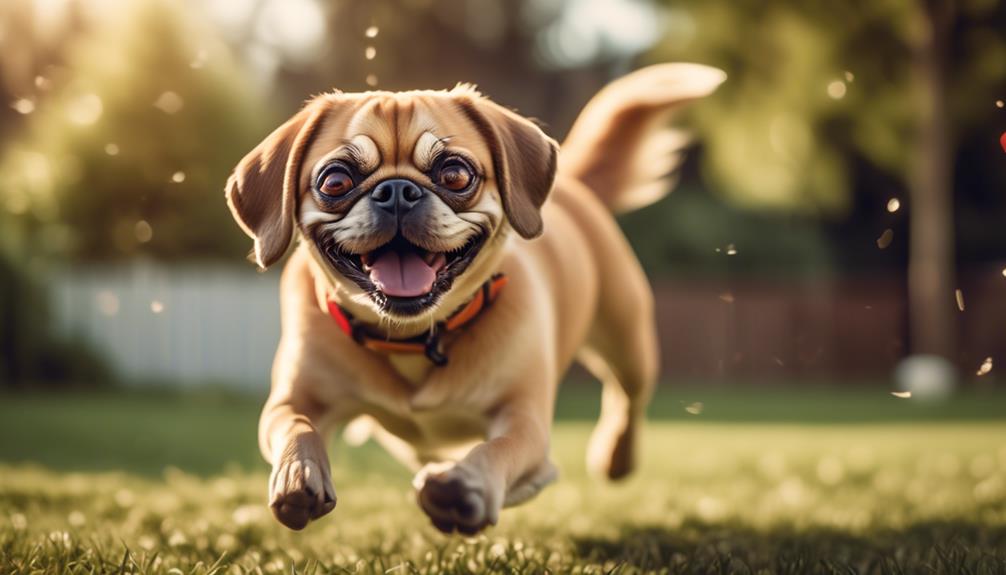
Now let’s explore the important aspects of exercise, playfulness, size, health, care, and feeding when it comes to Pugaliers.
Pugaliers have varying exercise needs depending on their energy level, which can differ among dog breeds. High-energy Pugaliers require significant exercise and mental stimulation, while low-energy ones are content with minimal physical activity. Providing enough exercise is important to prevent undesirable behaviors in high-energy dogs.
Playfulness in Pugaliers can be influenced by their breed and individual personality, with some dogs always seeking games.
Pugaliers are generally small in size, weighing between ten to 20 pounds and ranging in height from ten to 14 inches at the shoulder.
They can be prone to certain health issues, including hip dysplasia, heart conditions, patellar luxation, and dry eye. Regular veterinary checkups, a balanced diet, and proper care are necessary to maintain their health.
Pugalier Size

Pugaliers, a mixed breed of King Charles Spaniel and Pug, generally have a small size, weighing between ten to 20 pounds. When it comes to their size, there are a few key points to keep in mind:
- Size variation: Pugaliers are a mixed breed with no specific size standards. Their size can vary depending on the dominant genes of the parents. However, most Pugaliers tend to fall within the range of ten to 20 pounds.
- Height range: Pugaliers typically range in height from ten to 14 inches at the shoulder. This compact size makes them well-suited for both indoor and outdoor living.
- Parentage influence: The size of Pugaliers is influenced by their King Charles Spaniel and Pug parents. While they may be small in size, they’re big in personality and make great companions for individuals and families alike.
Pugalier Health
When considering the overall well-being of your Pugalier, it’s important to address their health needs and potential concerns.
Pugaliers can be prone to certain health issues. Common health problems include hip dysplasia, heart conditions, patellar luxation, and dry eye.
Hip dysplasia affects the hip joint and can cause pain and reduced mobility.
Heart conditions can affect dogs of all breeds and sizes.
Patellar luxation refers to a dislocated kneecap, causing lameness and mobility issues.
Dry eye affects tear production and can result in discomfort and potential damage to the cornea.
Regular veterinary checkups are important for maintaining Pugaliers’ health.
They’re prone to weight gain, so a balanced diet and regular exercise are necessary.
Checking and cleaning the ears daily is recommended.
Proper oral care, including daily teeth brushing, is crucial for small breeds like Pugaliers.
Pugalier Care
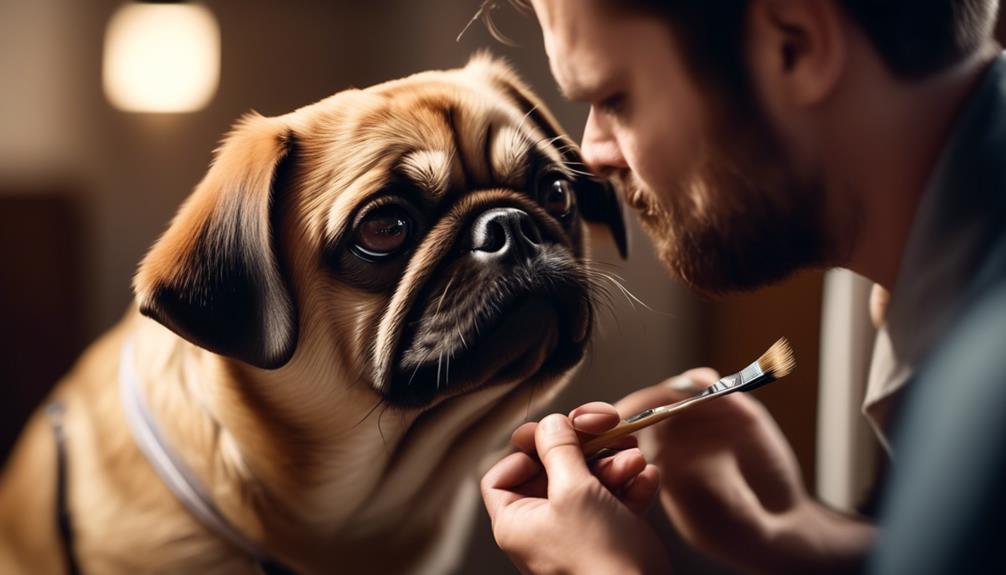
To properly care for your Pugalier, it’s essential to address their unique needs and provide the necessary attention and maintenance. Here are three key aspects of Pugalier care to keep in mind:
- Regular veterinary checkups:
Pugaliers can be prone to certain health issues, so it’s important to schedule regular checkups to monitor their overall health and address any potential concerns.
- Balanced diet and exercise:
Pugaliers are prone to weight gain, so it’s crucial to provide them with a balanced diet formulated for small breeds with moderate energy levels. Regular exercise is also necessary to keep them active and prevent obesity.
- Grooming and oral care:
Pugaliers require regular grooming, including checking and cleaning their ears daily and trimming their nails once or twice a month. Proper oral care, such as daily teeth brushing, is crucial for their dental health.
Pugalier Feeding

Feeding your Pugalier a balanced diet is crucial for their overall health and well-being. Pugaliers should be fed a diet formulated for small breeds with moderate energy levels. It is important to avoid overfeeding to prevent weight gain. Establishing feeding schedules and not leaving food out all day will help regulate their intake. As Pugaliers grow from puppyhood to adulthood, their dietary needs will change, so it is recommended to seek recommendations from a veterinarian. Consider individual variations in weight, energy levels, and health when determining the appropriate diet for your Pugalier. To give you a clearer picture, here is a table summarizing the key points for feeding your Pugalier:
| Feeding Your Pugalier |
|---|
| – Feed a balanced diet formulated for small breeds |
| – Avoid overfeeding to prevent weight gain |
| – Establish feeding schedules |
| – Seek recommendations from a veterinarian for dietary changes |
| – Consider individual variations in weight, energy levels, and health |
Conclusion

In summary, it’s important to prioritize the well-being and specific needs of your Pugalier when considering their feeding and overall care. Here are three key takeaways to consider:
- Health is paramount: Pugaliers can be prone to certain health issues such as hip dysplasia, heart conditions, patellar luxation, and dry eye. Regular veterinary checkups, a balanced diet, and proper oral care are crucial for maintaining their health.
- Exercise and playtime: Pugaliers have varying energy levels and exercise needs. It’s essential to provide them with enough physical activity and mental stimulation to prevent undesirable behaviors. Consider your own activity level and be prepared to engage in playtime with your furry companion.
- Feeding guidelines: Pugaliers should be fed a diet formulated for small breeds with moderate energy levels. It’s important to avoid overfeeding and establish a feeding schedule. As they grow, their dietary needs will change, so consult with a veterinarian for appropriate recommendations.
Frequently Asked Questions
Are Pugaliers Good With Children and Other Pets?
Yes, Pugaliers can be good with children and other pets. However, it’s important to socialize them early and supervise interactions. Each dog is unique, so consider their temperament and individual personality when introducing them to children and other animals.
How Much Exercise Does a Pugalier Need on a Daily Basis?
A Pugalier typically needs around 30 minutes to an hour of exercise on a daily basis. This can include walks, playtime, and mental stimulation. However, it’s important to consider your individual dog’s energy level and adjust accordingly.
Do Pugaliers Shed a Lot?
Yes, pugaliers do shed, but not excessively. Their short and smooth coat requires regular brushing to minimize shedding. Providing proper grooming and maintenance will help keep their shedding under control.
Are Pugaliers Prone to Separation Anxiety?
Yes, Pugaliers can be prone to separation anxiety. They form strong bonds with their owners and may become distressed when left alone for long periods. Proper training, gradual desensitization, and providing mental stimulation can help alleviate separation anxiety.
Are Pugaliers Easy to Train?
Yes, Pugaliers are generally easy to train. They are intelligent and eager to please, making them quick learners. Consistent positive reinforcement and reward-based training methods work well with this breed.
Conclusion
In conclusion, if you’re looking for a small, adorable, and friendly companion, the Pugalier dog breed may be the perfect fit for you.
With their unique mix of King Charles Spaniel and Pug parentage, Pugaliers have a charming personality and make great apartment pets. They’re playful, adaptable, and have minimal exercise needs.
However, it’s important to note their potential health concerns and provide proper care and feeding.
Overall, the Pugalier breed is a delightful choice for those seeking a furry friend.




